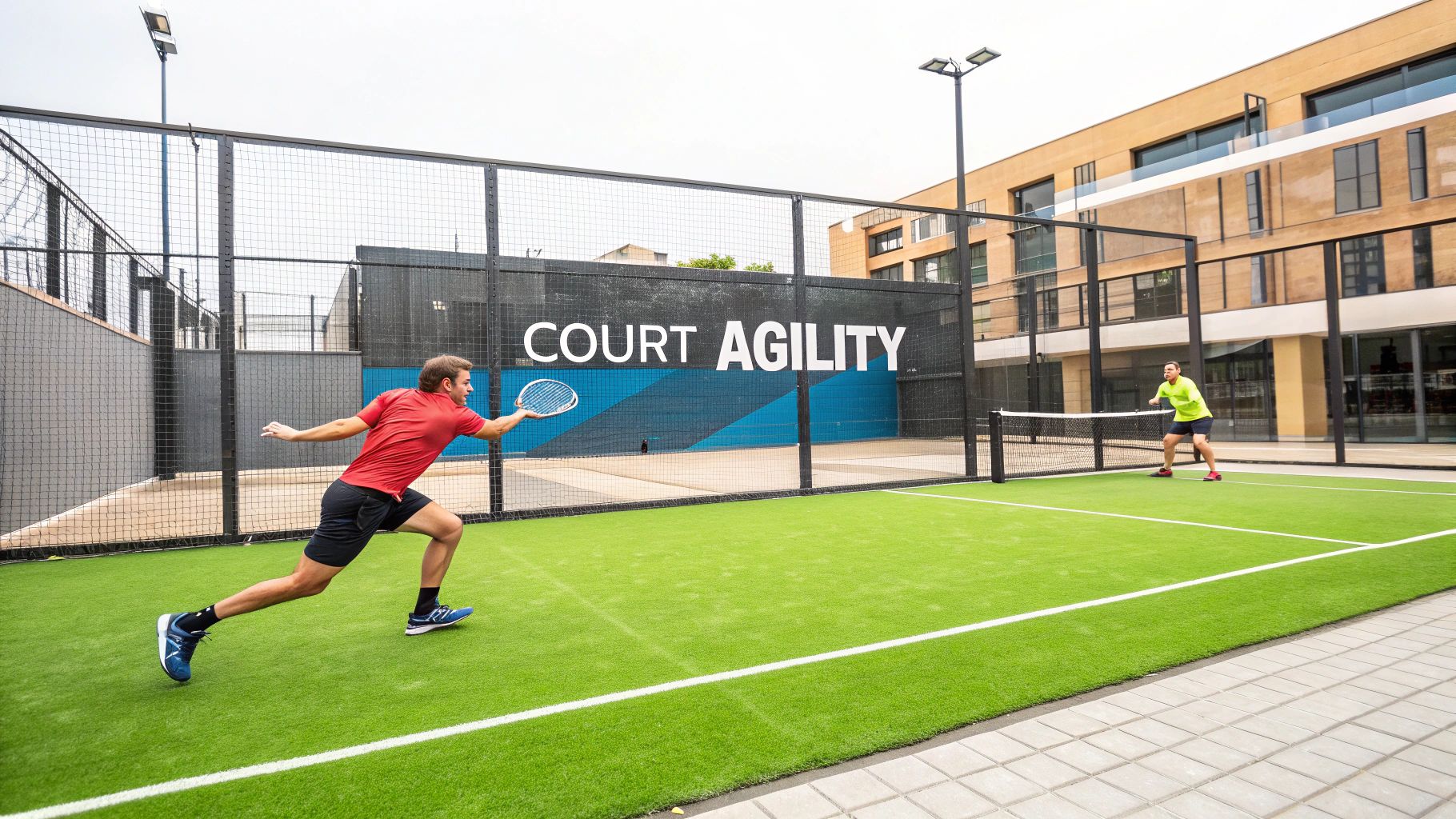In the fast-paced, enclosed world of padel, victory is often decided in a split second. It's not just about power or precision; it's about explosive, controlled movement. The ability to decelerate, pivot, and then accelerate in a new direction is what separates good players from great ones. This is where targeted training becomes crucial, moving beyond basic footwork to build elite-level agility.
Mastering change of direction isn't just a fitness goal, it is a strategic imperative. It directly translates to faster court coverage, superior defensive positioning, and more aggressive attacking opportunities at the net. When you can shift your momentum efficiently, you force your opponents into uncomfortable positions, creating openings that otherwise wouldn't exist. Effective change of direction drills are the key to developing this physical intelligence, training your body to react instinctively and powerfully.
This article moves beyond generic advice to provide a detailed breakdown of seven specific, high-impact change of direction drills, each adapted for the unique demands of the padel court. We'll explore the biomechanics, setup, and execution of fundamental exercises like the T-Drill and the Box Drill, offering actionable coaching points and clear progressions to elevate your game. Get ready to transform your movement, enhance your reaction time, and leave your opponents struggling to keep up.
1. Padel 'V' Drill: Mastering Offensive and Defensive Transitions
The Padel 'V' Drill is a foundational exercise designed specifically to mimic one of the most common and crucial movement patterns in the sport: the rapid transition from a defensive position at the back of the court to an attacking volley at the net. Unlike generic agility drills, this exercise directly translates to match scenarios, training your body to handle the swift backward-to-forward shift required after playing a lob or defending off the glass.
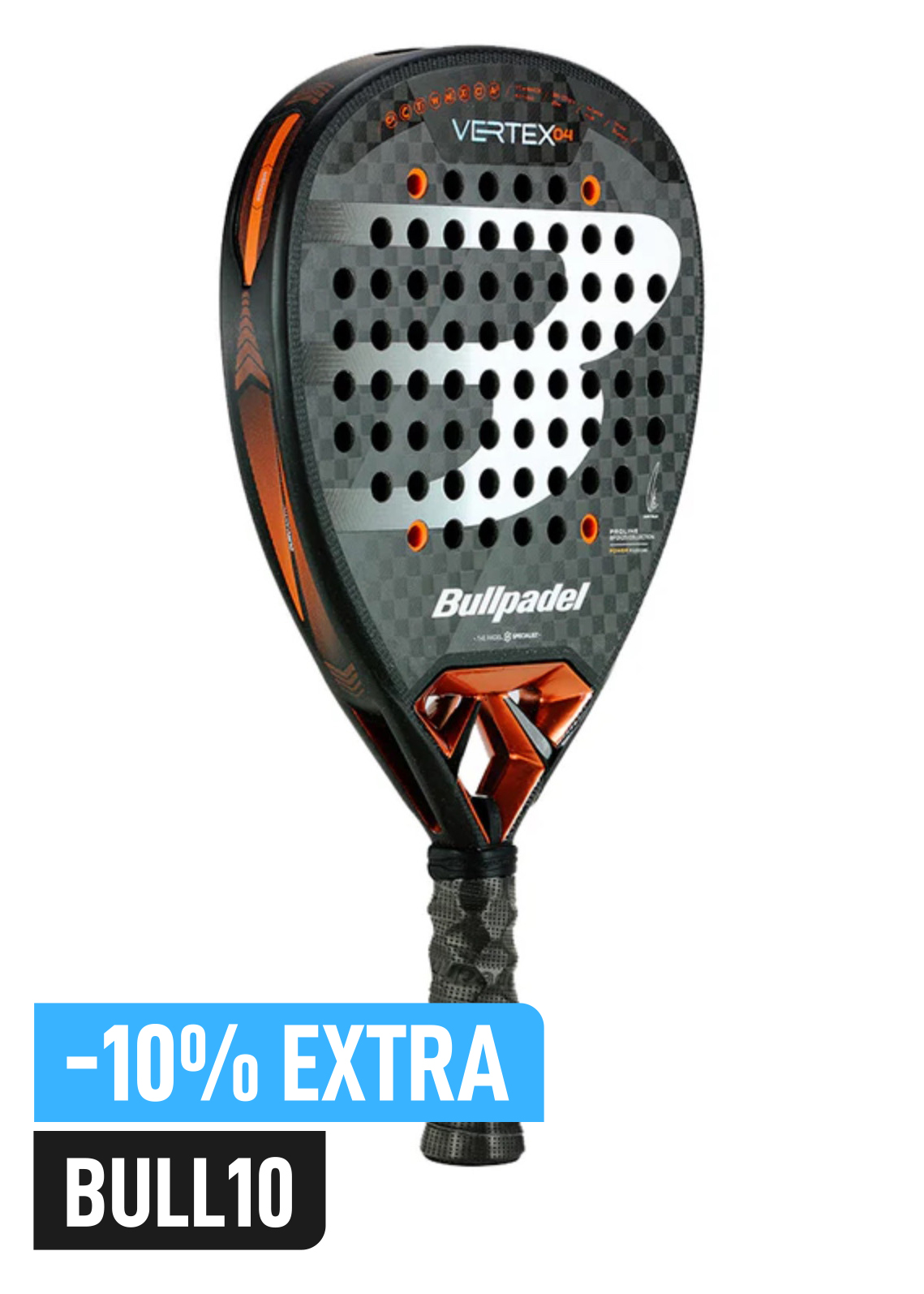
Buy the best padel gear to level up your next game!
CHECK OUT this deal from Padel Market!Get ready to take your game to the next level with the latest padel gear from Padel Market! Fast EU and Worldwide Shipping
This drill gets its name from the "V" shape your movement path creates on the court. It's one of the most effective change of direction drills because it isolates the explosive first step needed to gain control of the net, turning a defensive situation into an offensive opportunity in a split second.
The Setup
To perform this drill, you only need a few cones and a partner or coach to feed you balls.
- Starting Position: Place one cone (Cone A) centrally, about two meters behind the service line.
- Net Position: Place a second cone (Cone B) near the net post on your side of the court (either forehand or backhand side).
- Player Stance: Begin at Cone A in a ready, athletic stance, facing the net.
Step-by-Step Execution
The drill flows in a continuous, dynamic loop that simulates a real point.
- Defensive Movement: Your partner feeds a deep ball towards the corner. Move backward diagonally from Cone A to play a defensive shot (e.g., a lob or a drive) off the back glass.
- Recovery: After hitting the ball, immediately recover back to the starting cone (Cone A). This step is crucial for resetting your position.
- Offensive Transition: Your partner then feeds a shorter ball. Explode forward from Cone A towards Cone B at the net.
- The Volley: Intercept the short ball with a controlled volley, aiming for a specific target on the other side.
- Reset: Shuffle back to the starting cone (Cone A) and repeat the sequence. Aim for 8-10 repetitions before switching sides to work on both your forehand and backhand transitions.
Key Coaching Points and Progressions
To get the most out of the Padel 'V' Drill, focus on the finer details of your movement and technique.
- Low Center of Gravity: Maintain a low, athletic stance throughout the drill. When changing direction at Cone A, sink your hips to generate maximum power for your forward sprint.
- Split Step: Perform a small hop or "split step" just as your partner is about to feed the ball. This primes your muscles for a quick reaction in any direction.
- Efficient Footwork: Use a combination of shuffles, crossovers, and running steps. Avoid clicking your heels together. The goal is smooth, efficient movement, not just speed.
Pro Tip: For an advanced progression, have your feeder mix up the short and deep balls randomly. This forces you to read the play and react authentically, improving both your physical agility and your decision-making under pressure. Adding a third cone for a cross-court volley can further enhance the complexity and match-realism.
2. T-Drill (5-10-5 T-Test): Building Multi-Directional Agility
The T-Drill is a classic agility test and training exercise revered in multi-sport conditioning programs for its comprehensive assessment of an athlete's ability to accelerate, decelerate, and change direction. While not specific to padel, its T-shaped pattern forces you to master forward sprinting, lateral shuffling, and backpedaling, all of which are fundamental movements for covering the court effectively.
This exercise stands out as one of the most effective change of direction drills because it challenges your body to transition between different movement planes under pressure. Its structured 5-10-5 yard format is excellent for building the coordination and footwork needed for rapid, controlled movements like defending a smash at the back glass and then quickly shuffling to cover a drop shot.
The Setup
Setting up the T-Drill is simple and only requires three cones. This drill is typically performed on a court or open field with clearly marked distances.
- Starting Position: Place one cone (Cone A) as the starting and finishing point.
- Central Cone: From Cone A, measure 10 yards forward and place a second cone (Cone B).
- Lateral Cones: From Cone B, measure 5 yards to the left and place Cone C. Then, measure 5 yards to the right of Cone B and place Cone D, creating a "T" shape.
Step-by-Step Execution
The drill is performed for time, emphasizing speed, control, and precise footwork through each transition.
- Forward Sprint: Start at Cone A. On your go-signal, sprint forward and touch the base of Cone B with your hand.
- Lateral Shuffle (Left): From Cone B, immediately push off and shuffle laterally to your left, touching the base of Cone C with your left hand. Do not cross your feet.
- Lateral Shuffle (Right): Immediately change direction and shuffle 10 yards to your right, all the way to Cone D. Touch the base of Cone D with your right hand.
- Recovery Shuffle: Shuffle back to your left and touch the base of Cone B again with your left hand.
- Backpedal: From Cone B, backpedal quickly past the starting cone (Cone A). Your time stops once you cross the line at Cone A. Aim for 3-5 repetitions with adequate rest in between.
Key Coaching Points and Progressions
To maximize the benefits and reduce the risk of injury, concentrate on maintaining proper form throughout the drill.
- Athletic Stance: Keep your hips low, chest up, and shoulders square to the forward direction, especially during the lateral shuffles. This posture ensures balance and explosive power.
- Quick Foot Contacts: Focus on light, rapid steps. The less time your feet spend on the ground, the faster you can change direction. Avoid heavy, stomping steps.
- Drive with Your Arms: Use your arms to help generate momentum during the sprint and maintain balance during the shuffles and backpedal.
Pro Tip: To make this drill more padel-specific, have a partner give you visual or auditory cues at each cone, forcing you to react rather than just follow a pattern. This will sharpen your court awareness and improve your reflexes for padel. For an advanced progression, incorporate a medicine ball hold to challenge your core stability and power.
3. Box Drill (4-Corner Drill): Building 360-Degree Agility
The Box Drill, often called the 4-Corner Drill, is a staple in multi-sport athletic training for its unparalleled ability to develop comprehensive, 360-degree agility. It forces athletes to transition seamlessly between forward sprints, lateral shuffles, and backward movements within a confined space, directly mimicking the unpredictable footwork required in sports like padel, football, and boxing.
This exercise is one of the most versatile change of direction drills because it can be easily modified to train different movement patterns and energy systems. It builds the foundation for efficient footwork, teaching an athlete how to stay balanced and explosive while navigating a variety of directional shifts in quick succession.
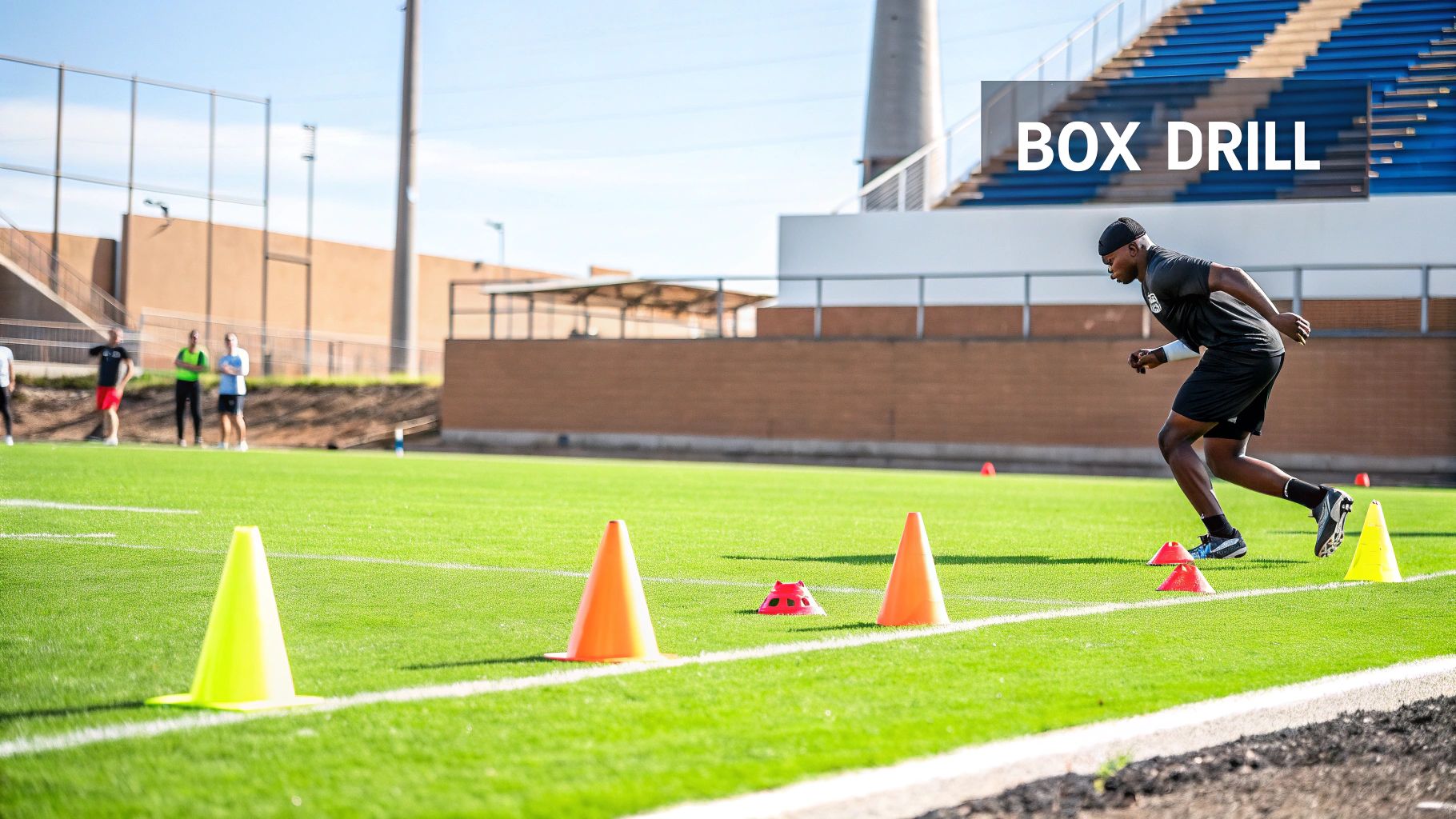
The Setup
The beauty of the Box Drill lies in its simplicity. All you need are four cones to create your training grid.
- Cone Placement: Arrange four cones in a square shape. For most sports, a 5×5 yard or 10×10 yard square provides an ideal balance of challenge and space.
- Player Stance: Begin at one of the bottom corners (Cone A) in a low, athletic ready position.
Step-by-Step Execution
A standard execution of the drill involves moving around the perimeter of the box, but the patterns are endless. Here is a common sequence:

Buy the best padel gear to level up your next game!
CHECK OUT this deal from Padel Market!Get ready to take your game to the next level with the latest padel gear from Padel Market! Fast EU and Worldwide Shipping
- Forward Sprint: From Cone A, sprint forward to the cone directly in front of you (Cone B).
- Lateral Shuffle: Upon reaching Cone B, drop your hips and perform a lateral shuffle across to the adjacent cone (Cone C) without crossing your feet. Keep your chest facing forward.
- Backpedal: At Cone C, transition immediately into a backpedal, moving backward to the final cone (Cone D).
- Lateral Shuffle Return: From Cone D, shuffle laterally back to the starting cone (Cone A) to complete the square.
- Reset: Take a brief rest and then repeat the drill, either in the same direction or by reversing the pattern. Aim for 3-5 repetitions per set.
Key Coaching Points and Progressions
To maximize the benefits of the Box Drill, focus on the quality of each movement rather than just the speed.
- Low Center of Gravity: Stay low throughout the entire drill. Sink your hips, especially during shuffles and when changing direction at each cone, to maintain balance and power.
- Head and Eyes Up: Keep your eyes looking forward, not down at the cones. In a game, this translates to keeping your eyes on the opponent or the ball.
- Sharp Transitions: Focus on planting your outside foot firmly at each cone to decelerate and accelerate into the next movement. The transition should be sharp and explosive.
Pro Tip: To increase complexity and cognitive load, have a coach call out which cone to move to next, forcing you to react rather than follow a set pattern. You can also incorporate different movements like carioca steps or diagonal sprints across the box to further enhance its sport-specific application.
4. Illinois Agility Test: The Gold Standard for Agility Measurement
The Illinois Agility Test is a globally recognized benchmark used to measure an athlete's ability to accelerate, decelerate, turn, and weave. Originally developed by researchers at the University of Illinois, this test has become a staple in military, law enforcement, and elite athletic conditioning programs, including those for European soccer players. Its comprehensive pattern covers 60 meters of total distance, forcing rapid and repeated directional shifts.
While it's a test, its structure makes it one of the most effective change of direction drills you can practice. It challenges your body to navigate a complex sequence of movements, improving your ability to maintain speed and control through multiple transitions, a skill essential for covering the padel court during chaotic, unpredictable rallies.
The Setup
The setup for the Illinois Agility Test is standardized to ensure accurate and repeatable results. You will need a measuring tape, eight cones, and a stopwatch.
- Course Dimensions: Mark out a rectangular area 10 meters long and 5 meters wide.
- Start/Finish Line: Place two cones to mark the start line and two cones for the finish line at each end of the 10-meter length.
- Weaving Cones: Place four cones in a straight line down the center of the rectangle. The first cone is 3.3 meters from the start line, and the remaining three cones are each spaced 3.3 meters apart.
- Player Stance: Begin by lying face down on the ground, with your head at the start line and hands by your shoulders.
Step-by-Step Execution
The test begins on the timer's command and involves a precise sequence of movements.
- Initial Sprint: On "Go," push up and sprint 10 meters forward to the far end of the course.
- First Turn: Touch the line with your foot and turn 180 degrees.
- Weaving Pattern: Sprint back and weave in and out of the four center cones.
- Second Turn: After the last cone, sprint to the far end of the course (the original start line).
- Third Turn: Touch the line, turn 180 degrees, and sprint back.
- Reverse Weave & Finish: Weave back through the four center cones in the opposite direction and finish with a final 10-meter sprint through the finish line. The timer stops when you cross the finish line.
Key Coaching Points and Progressions
To maximize your performance and training benefit, concentrate on efficiency and technique.
- Tight Turns: When weaving, stay as close to the cones as possible without touching them. Focus on planting your inside foot to pivot sharply and drive out of the turn.
- Maintain Momentum: Avoid coming to a complete stop during the 180-degree turns. Instead, lower your center of gravity and use a "rolling" turn to carry your speed through the change of direction.
- Master the Weave: Before attempting the full test at high speed, walk through the weaving pattern. Practice it separately to build muscle memory and improve your footwork efficiency.
Pro Tip: For a padel-specific progression, perform the test while holding your racket. This adds a layer of sport-specific coordination. You can also have a partner feed you a volley at the end of the final sprint, forcing you to transition from maximum physical exertion directly into a skilled, controlled shot.
5. W-Drill: Enhancing Multi-Directional Agility and Footwork
The W-Drill is a classic agility exercise, popularized by football and track coaches, that forces athletes to master rapid transitions between forward sprints, diagonal backpedaling, and lateral shuffles. While it doesn't involve a ball, its focus on pure movement mechanics makes it an essential tool for building the foundational footwork required for complex court coverage in padel. This drill is renowned for its ability to improve an athlete's body control when decelerating and re-accelerating in multiple directions.
Its name comes from the "W" shape traced by the athlete's path between five cones. As one of the most versatile change of direction drills, it directly enhances your ability to cover the baseline, react to drop shots, and quickly reset your defensive position, mimicking the chaotic, multi-directional nature of a high-paced rally.
The Setup
This drill requires five cones and enough open space to arrange them properly. Precision in cone placement is key to targeting the correct movement patterns.
- Starting Position: Place two cones (Cone 1 and Cone 2) about five yards apart to form the base of the W.
- Apex Cones: Place three more cones (Cone 3, Cone 4, and Cone 5) five yards forward, staggered between the first two. Cone 4 should be directly in the middle, and Cones 3 and 5 should be aligned diagonally from Cones 1 and 2, respectively, to create the W-shape.
- Player Stance: Begin at Cone 1 in a low, athletic stance.
Step-by-Step Execution
The drill is performed in a fluid, continuous sequence, emphasizing sharp, clean transitions at each cone.
- Forward Sprint: From Cone 1, sprint forward at a 45-degree angle to Cone 3.
- Diagonal Backpedal: Plant your outside foot at Cone 3 and immediately backpedal diagonally to Cone 2. Keep your hips low and your eyes forward.
- Second Sprint: Upon reaching Cone 2, plant and explode forward at a 45-degree angle to Cone 4.
- Second Backpedal: Plant at Cone 4 and backpedal diagonally to Cone 1.
- Final Sprint: Plant at Cone 1 and finish by sprinting forward to Cone 5.
- Reset: Walk back to the starting position. Aim for 4-6 full repetitions, focusing on form over speed initially.
Key Coaching Points and Progressions
To truly benefit from the W-Drill, concentrate on efficient movement and maintaining balance through each transition.
- Head and Eyes Up: During the backpedal segments, resist the temptation to look down at your feet. Keeping your head up simulates match play where you must track the ball and your opponents.
- Active Arms: Pump your arms vigorously throughout the drill. This helps drive momentum during sprints and maintain balance during the sharp changes of direction.
- Short, Choppy Steps: When approaching a cone to change direction, use short, choppy steps to decelerate under control. This allows for a more powerful and explosive push-off into the next movement.
Pro Tip: For an advanced progression, have a coach or partner stand at the end and point left or right as you finish at Cone 5, forcing you to react with a final lateral shuffle. This adds a reactive component, which is crucial for padel, and helps sharpen the connection between visual cues and physical response. For more insight into this connection, discover how to improve hand-eye coordination.
6. Hexagon Drill: Forging 360-Degree Reactive Agility
The Hexagon Drill is a classic plyometric exercise renowned for developing rapid, multi-directional footwork and explosive power from a stationary base. Unlike drills that focus on linear sprints or simple forward-and-back transitions, this exercise forces an athlete to change direction across six different planes in quick succession. It trains the neuromuscular system to fire signals for immediate, controlled jumps and landings in any direction.
This agility test is one of the most effective change of direction drills for building ankle stability, coordination, and reactive quickness. It's particularly beneficial for sports where athletes must constantly adjust their footing within a confined space, such as a basketball player boxing out for a rebound or a volleyball player adjusting their approach for a spike.
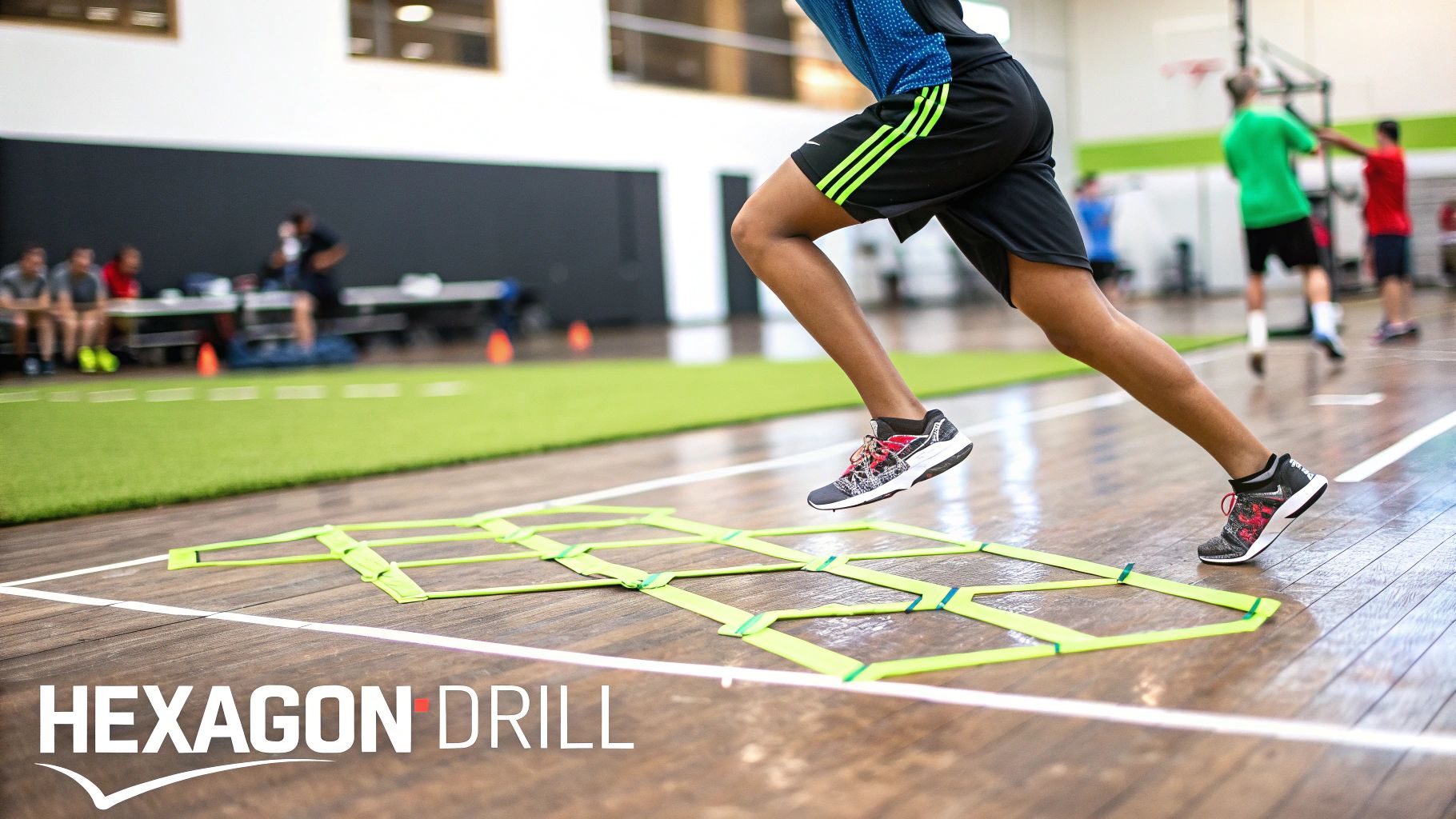
The Setup
The setup for the Hexagon Drill is simple and requires minimal equipment, making it easy to perform almost anywhere.
- The Hexagon: Create a hexagon on the ground using tape, chalk, or six cones. Each side should be approximately 24 inches (60 cm) long.
- Player Stance: Stand in the center of the hexagon in an athletic, ready stance with your feet shoulder-width apart and knees slightly bent.
Step-by-Step Execution
The drill is performed by jumping in and out of the hexagon in a continuous, clockwise or counter-clockwise pattern. The key is to maintain speed and rhythm.
- Start Position: Begin in the center of the hexagon, facing one of the sides.
- Forward and Back: With your feet together, jump forward over the line in front of you, then immediately jump backward to return to the center.
- Clockwise Movement: Without pausing, jump diagonally forward over the next line in a clockwise direction. Immediately jump backward to the center again.
- Continue the Pattern: Continue this in-and-out pattern for all six sides of the hexagon until you have completed a full rotation and are back at your starting point.
- Repeat: Complete 2-3 full rotations in one direction, then rest and repeat in the opposite (counter-clockwise) direction.
Key Coaching Points and Progressions
To maximize the benefits of the Hexagon Drill, precision and control are more important than raw speed, especially when starting out.
- Brief Ground Contact: The goal is to be explosive. Minimize the amount of time your feet are on the ground. Think of the floor as a hot surface.
- Land on the Balls of Your Feet: Absorb impact by landing softly on the balls of your feet with your knees slightly bent. This protects your joints and primes your muscles for the next jump.
- Upright Posture: Keep your chest up and your core engaged throughout the exercise. Avoid bending at the waist, as this compromises your balance and power.
Pro Tip: For an advanced progression, perform the drill on one leg to drastically increase the demand on your balance, ankle stability, and unilateral power. Alternatively, a coach or partner can call out numbers corresponding to the hexagon's sides, forcing you to react and jump to a random side instead of following a set pattern.
7. 3-Cone Drill (L-Drill): Testing High-Speed Agility and Body Control
The 3-Cone Drill, famously known as the L-Drill, is a benchmark test of athletic performance used in elite sports like the NFL Combine to evaluate an athlete's ability to change direction at high speed while maintaining balance and body control. While not specific to padel, its principles are universal, training the exact explosive deceleration and re-acceleration needed to handle unpredictable, fast-paced rallies and cover the court effectively.
This drill is one of the most demanding change of direction drills because it forces athletes to navigate tight turns and complex patterns without losing momentum. For a padel player, mastering this translates to superior court coverage, quicker reactions to angled shots, and the ability to rapidly transition from a wide defensive stance to an aggressive net position.
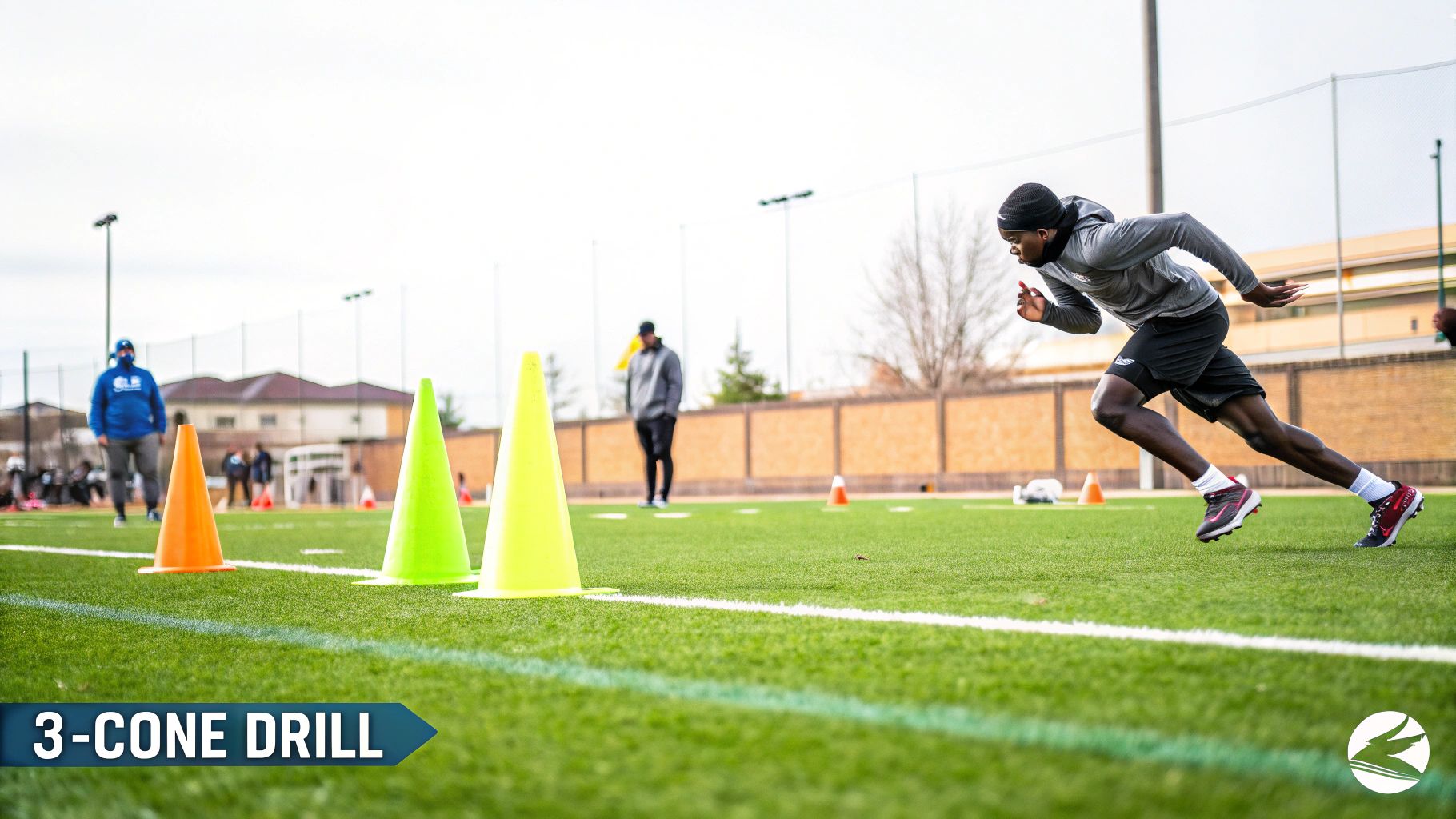
The Setup
The setup is simple and requires only three cones arranged in an "L" shape.
- Cone Arrangement: Place three cones in an L-shape. Cone 1 is the starting point. Cone 2 is five yards straight ahead. Cone 3 is five yards to the side (left or right) of Cone 2, forming a right angle.
- Player Stance: Begin at Cone 1 in a three-point stance or an athletic ready position, preparing to explode forward.
Step-by-Step Execution
The drill is performed as a single, continuous, high-intensity sequence.
- Initial Sprint: From Cone 1, sprint five yards to Cone 2.
- First Touch and Return: Touch the line at Cone 2 with your hand, immediately turn, and sprint back to Cone 1.
- Figure-Eight Turn: Touch the line at Cone 1, then turn and weave around Cone 2.
- Final Weave and Finish: Continue in a figure-eight pattern, looping tightly around Cone 3.
- Finish Sprint: Once you clear Cone 3, straighten your path and sprint past the starting line at Cone 1. Rest and repeat, aiming for maximum speed on each repetition.
Key Coaching Points and Progressions
To truly benefit from the L-Drill, precision in your movements is just as important as raw speed.
- Stay Low: Keep your hips low and your center of gravity down, especially when navigating the tight turns around the cones. This allows for sharper cuts and greater stability.
- Use Your Hands: Use your inside hand to touch the line at each cone. This helps lower your body position and provides a pivot point to accelerate out of the turn.
- Accelerate Out of Turns: Focus on exploding out of each turn rather than running into it. The goal is to minimize deceleration time and maximize acceleration in the new direction. This is a key skill you can explore in other exercises for reaction time.
Pro Tip: For a padel-specific progression, perform the drill holding your racket. After completing the sprint, have a partner feed you a quick volley or bandeja. This forces you to transition from pure athletic movement back into a technical, on-court action, simulating the demands of a high-pressure point.
Change of Direction Drills Comparison
| Drill Name | Implementation Complexity 🔄 | Resource Requirements ⚡ | Expected Outcomes 📊 | Ideal Use Cases 💡 | Key Advantages ⭐ |
|---|---|---|---|---|---|
| 5-10-5 Pro Agility Shuttle | Low (simple setup, 3 lines) | Minimal (space for 20 yards, 3 lines) | Measures acceleration/deceleration, lateral power | Quick direction change sports, NFL Combine testing | Benchmarked, easy progress tracking, linear power focus |
| T-Drill (5-10-5 T-Test) | Moderate (cone arrangement, multiple movements) | Moderate (T-shaped setup, 25 yards) | Develops multi-directional agility, coordination | Basketball, tennis, hockey, tactical/military training | Multi-plane agility, coordination, functional strength |
| Box Drill (4-Corner Drill) | Moderate to High (multiple movement patterns) | Higher (4 cones, larger space) | Enhances footwork, spatial awareness, endurance | Football DB, soccer GK, martial arts, dance | Versatile, customizable, 360° directional training |
| Illinois Agility Test | High (complex pattern, precise setup) | Significant (large area, many cones) | Comprehensive agility, cognitive and physical challenge | Soccer fitness, military, university benchmarking | International standard, valid reliable measurement |
| W-Drill | Moderate (accurate cone placement) | Moderate (5 cones, 40-50 yards) | Backward-forward transitions, hip mobility | Football defense, tennis, basketball, ultimate frisbee | Improves transitions, hip mobility, deceleration |
| Hexagon Drill | Low to Moderate (simple hex pattern) | Low (small space, minimal equipment) | Explosive power, reactive agility, landing mechanics | Volleyball, basketball, gymnastics, climbing | Plyometric, improves balance and quickness |
| 3-Cone Drill (L-Drill) | Moderate (figure-8 pattern) | Minimal to Moderate (3 cones, 20 yards) | Tight turning, body control, linear and curved running | NFL Combine, football, soccer, rugby | Gold standard, predicts cutting ability, well-studied |
Integrating These Drills into Your Padel Routine
Mastering the explosive, multi-directional movement required in padel is not a one-time achievement; it's a continuous process of refinement. The seven change of direction drills detailed in this guide, from the classic T-Drill to the rapid-fire Hexagon Drill, are your essential building blocks for creating a foundation of superior agility. They are not just abstract fitness exercises; they are direct simulations of the dynamic footwork needed to dominate the court.
The true value of this toolkit is unlocked through consistent, intelligent, and progressive application. Rushing to perform all seven drills in a single session is a recipe for fatigue and poor form. A more strategic approach will yield far greater results and minimize the risk of injury.
Building Your Agility Training Plan
Your first step is integration, not addition. Think of these drills as a core component of your training regimen, not an afterthought.
- Start Small, Aim for Quality: Begin by selecting just two or three drills to incorporate into your routine. For example, you could pair a linear drill like the 5-10-5 Pro Agility Shuttle with a multi-directional one like the Box Drill. Focus on mastering the footwork and body mechanics of these few before adding more complexity.
- Prioritize Form Over Speed: When you first start, your primary goal is perfect execution. Move through the patterns deliberately, paying close attention to your center of gravity, foot placement, and body posture. Sloppy, rushed repetitions build bad habits that are difficult to unlearn. Speed will come naturally as your neuromuscular system adapts and your movements become more efficient.
- Schedule for Success: Dedicate specific time slots for this work. You can perform these drills two to three times per week. They work exceptionally well as a dynamic warm-up to activate your nervous system before a match or as a standalone fitness block on a non-playing day.
Key Insight: Agility is a skill. Like any skill, it requires deliberate practice. By focusing on the quality of each turn, crossover, and sprint, you are teaching your body to move more effectively under pressure.
From Competence to Mastery: Progressing Your Drills
Once you have established a baseline of solid technique, you can begin to increase the challenge. This progressive overload is what forces your body to adapt and improve.
- Increase Intensity: Start to push your speed. The goal is to perform each repetition at or near maximum effort while maintaining proper form. This trains your body to accelerate and decelerate powerfully, just as you would when chasing a drop shot or defending a smash.
- Reduce Rest Times: Shorten the recovery period between repetitions and sets. This will not only challenge your agility but also significantly boost your anaerobic conditioning. As you commit to these agility drills, you'll naturally enhance your on-court endurance. For a deeper dive into how to effectively improve overall stamina and lasting energy through consistent training, you might find this guide beneficial.
- Incorporate Padel-Specific Elements: Begin adding a racket and ball. Have a partner feed you a ball at the end of a W-Drill or require a volley after completing a Hexagon Drill pattern. This crucial step bridges the gap between raw physical ability and functional, on-court skill.
By making these change of direction drills a non-negotiable part of your training, you are investing directly in your performance. You will build the athletic foundation that allows you to reach more balls, maintain better balance on difficult shots, and recover your position faster than your opponents. This is how you transform from a static player into a dynamic and unpredictable force on the court.
Ready to stay ahead of the curve with the latest in padel? For exclusive insights on player performance, emerging gear, and professional training secrets that can sharpen your game, check out Padel Rumors. Get the inside scoop that elevates your play and keeps you informed on everything happening in the world of padel. Visit Padel Rumors to join the conversation.





